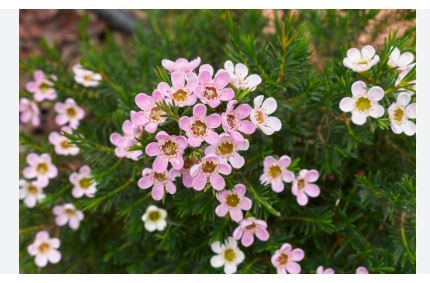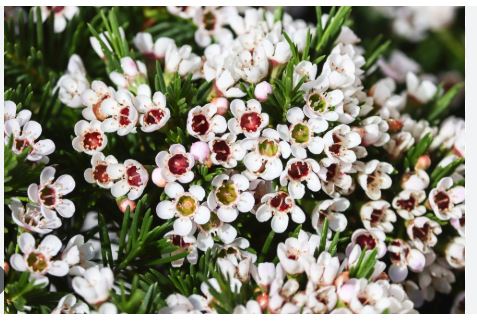
Waxflower, belonging to the genus Chamelaucium, is part of the Myrtaceae family, which includes other aromatic plants like eucalyptus and tea-trees (Leptospermum). The genus Chamelaucium comprises about 30 species, with Chamelaucium uncinatum (Geraldton wax) being the most prominent. First described by French botanist René Louiche Desfontaines in 1819, the genus name’s origin is debated, possibly deriving from Greek “chamai” (dwarf) and “leucos” (white), or linked to medieval papal headgear. As a dicot, Chamelaucium shares the Myrtaceae family’s traits of woody stems, oil-rich leaves, and small, clustered flowers, aligning it with Australia’s diverse native flora adapted to challenging environments.
Waxflowers are evergreen shrubs, ranging from 6 inches to 10 feet (15 cm–3 meters) tall, with a dense, upright to spreading habit. Their needle-like leaves, 0.4–1.6 inches (1–4 cm) long, are narrow, opposite, and aromatic, releasing a citrusy or pleasant scent when crushed due to oil glands. Flowers, blooming from late winter to spring, are star-shaped, 0.5–1 inch (1.3–2.5 cm) wide, with five waxy petals in shades of white, pink, purple, or red, often with a central cup-like structure. The blooms, long-lasting when cut, are followed by small, hardened capsules. The foliage is typically dark green to gray-green, with reddish stems adding contrast, making the plant visually striking year-round.
Chamelaucium species are endemic to southwestern Western Australia, thriving in sandy heathlands, coastal dunes, granite outcrops, and semi-arid plains. They are adapted to nutrient-poor soils and Mediterranean climates with wet winters and dry summers. Chamelaucium uncinatum, the most widespread, is native to the Geraldton region and Shark Bay, though cultivation has spread it across Australia, including Sydney, where it is less long-lived due to humidity. Globally, waxflowers are grown in Mediterranean climates, such as California, Israel, and southern Europe, for ornamental and cut-flower purposes, but they remain rooted in Western Australia’s unique ecosystems.
Waxflowers are hardy in USDA zones 9a–11, tolerating temperatures as low as 27°F (-3°C) for short periods, with some cultivars surviving light frosts if sheltered. They thrive in warm, dry climates with temperatures between 50°F and 85°F (10°C–29°C), ideal for Mediterranean and coastal regions. In zones 8b or below, they are grown in containers or greenhouses, brought indoors during winter to avoid frost damage. Their sensitivity to high humidity and poor drainage makes them less suited to tropical or cold, wet climates, requiring careful site selection in marginal zones.
Waxflowers are prized in landscaping for their vibrant blooms, drought tolerance, and versatility. They shine in xeriscapes, rock gardens, and Mediterranean-style designs, where their airy structure adds texture as border plants, low hedges, or mass plantings. Single shrubs make excellent focal points in mixed beds, complementing natives like grevilleas or kangaroo paws. Their long-lasting flowers are ideal for cut-flower gardens, attracting bees, butterflies, and birds, enhancing biodiversity. In coastal gardens, they tolerate sandy soils and wind, while in containers, they brighten patios or balconies. Regular pruning maintains shape, ensuring a tidy appearance in formal or informal settings.

Waxflower (Chamelaucium): Cultivation
Light Requirements
Provide full sun, with at least 6–8 hours of direct sunlight daily, to ensure prolific flowering and compact growth. Waxflowers thrive in bright, open conditions mimicking their native heathlands. Partial shade reduces blooms and causes leggy growth, so prioritize sunny, unshaded locations for optimal performance.
Soil Preferences
Plant in well-draining, sandy, or gravelly soil with a pH of 5.5–6.5, reflecting their native nutrient-poor habitats. Avoid heavy clay or rich soils, which retain water and harm roots; amend with sand or perlite for drainage. In containers, use a native plant or cactus mix to ensure aeration and minimal water retention.
Watering Needs
Water moderately during the first year to establish roots, about 1 inch (2.5 cm) weekly, keeping soil moist but not soggy. Once established, water every 2–3 weeks in summer, allowing soil to dry completely between waterings, and reduce in winter. Overwatering causes root rot, so monitor closely to avoid excess moisture.
Temperature Range
Grow in USDA zones 9a–11, where temperatures range from 27°F to 85°F (-3°C to 29°C). Waxflowers tolerate light frosts but may suffer foliage damage below 30°F (-1°C); protect with frost cloth in zones 9a–9b. In colder zones, cultivate in pots and move indoors during winter, maintaining above 50°F (10°C).
Humidity Levels
Prefer low to moderate humidity (30–50%), suited to Mediterranean climates. High humidity promotes fungal issues like root rot or leaf spot, so ensure good air circulation. Indoor plants need dry air; avoid humid rooms or misting, as excess moisture damages their aromatic, needle-like leaves.
Container Selection
Choose pots with drainage holes to prevent water buildup. Terracotta or plastic pots, 12–18 inches (30–45 cm) wide, support the shrub’s root system. Ensure the container is stable for its upright growth, repotting every 2–3 years to refresh soil and accommodate slow expansion.
Fertilization
Apply a low-phosphorus, slow-release fertilizer (e.g., 10-5-10 NPK) designed for native plants in early spring to support flowering. Feed monthly with diluted liquid fertilizer during spring–summer. Avoid high-phosphorus formulas, as they harm Australian natives, causing weak growth or reduced blooms.
Pruning
Prune lightly after flowering (late spring to early summer) to shape the plant and encourage bushiness, removing one-third of new growth with clean shears. Tip-prune regularly to maintain density, avoiding heavy cuts that stress the plant. Remove dead or crossing branches to improve airflow and prevent disease.
Propagation
Propagate via semi-hardwood cuttings or seeds. Take 3–4-inch (7.5–10 cm) cuttings in spring, dip in rooting hormone, and plant in a sandy mix; roots form in 6–8 weeks. Seeds, sown in spring at 65–75°F (18–24°C), germinate in 4–6 weeks but are less reliable due to variable viability.
Pest Control
Monitor for pests like aphids, scale, or spider mites, which may target new growth. Inspect leaves and stems, treating infestations with insecticidal soap or neem oil in early morning. Maintain proper watering and prune for airflow to reduce pest risks, as healthy plants are more resistant.
Repotting
Repot every 2–3 years in spring, or when roots crowd the container. Gently remove the plant, trim dead roots, and replant in fresh native plant mix at the same depth. Water sparingly after repotting, keeping in partial shade for a week to ease transplant shock, ensuring excellent drainage.
Winter Care
In zones 9a–9b, mulch the base with 2 inches (5 cm) of gravel or bark to insulate roots during cold snaps. Cover with frost cloth if frost is forecast. Indoor plants need bright light, cool temperatures (50–60°F/10–16°C), and minimal watering in winter to mimic their dormant phase.
Common Issues
Address overwatering (yellowing leaves, root rot) by improving drainage and reducing frequency. Underwatering (wilting, leaf drop) requires slight watering increases. Poor flowering may stem from insufficient sun or incorrect fertilizer; adjust light or use low-phosphorus feed. Fungal issues from humidity are mitigated with better airflow and dry conditions.